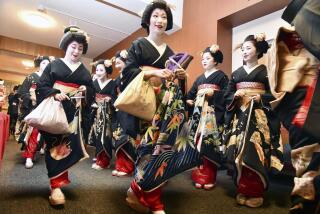Rules of the Road for Japan Hitchhikers
- Share via
One way to cut your transportation costs in Japan is to dress like a nerd, stick out your thumb and learn to bow, according to Will Ferguson, who once toured the length of Japan in 18 days, thanks to residents who provided 48 rides. Of course, nobody warned him about the slippers.
Hitchhiking always puts you at some risk, and in many areas of the world, far too much risk to ever consider it. Nevertheless, for Ferguson, who traveled by thumb in Japan for more than five years, it proved to be a cheap, satisfying way to explore beyond Japan’s massive urban centers.
“The people are kind to visitors, and the back roads can be breathtakingly beautiful,” he says. So he gathered all of his tips and advice for like-minded souls and created “The Hitchhikers’s Guide to Japan” (Charles E. Tuttle Co., $12.95).
Whether you plan to stick out your thumb or use more conventional transportation, you’ll find this book will lead you away from the hectic, crowded cities to more rural regions of the country. It offers suggestions for promising routes, budget accommodations and economical sightseeing opportunities, along with tips on hitchhiking etiquette.
You’ll find Ferguson’s advice and insights on curious cultural differences helpful. For example, slippers for passengers may show up in new cars or vans. The best thing to do is gesture to the driver, and he or she will probably signal for you not to worry about using them. And, he explains, hitchhiking is rare in Japan. So when foreign travelers are offered rides, they are treated as friends, and it would be rude to carry on a lengthy English-language conversation, which would make the driver feel left out.
“The most persistent mistake hitchhikers make in Japan,” Ferguson learned, “is to assume that what works in Western countries will work in Japan. This is no time for faded, patched-up jeans and old T-shirts. . . . In Japan, you should strive to look like a Boy or Girl Scout who happens to be waiting cheerfully for some kind person to offer them a ride.”
Any traveler to Japan should become familiar with two popular Japanese traditions: bowing and gifts. Ferguson found it was true for hitchhikers too.
“When you do get a ride, a slight nod is appropriate. You may want to bow as each car passes as well, but this can get hard on the back. Bowing does work, though.” He advises, “Don’t make theatrical, deep bows. In Japan, bowing is closer to nodding, except that you nod from the waist. A slight bobbing action is all that you need.” The best way to show your appreciation to a driver is with a small gift, so have a supply of them, from stickers for children to pins and coins.
Who definitely shouldn’t hitchhike? According to Ferguson, single women and pairs of men may not get rides because they could seem intimidating. Who picks up hitchhikers? Ferguson was offered rides by Buddhist priests, retired couples, university students, lots of English teachers, a sushi chef and a woman who taught the tea ceremony.
Along with detailed information on good routes, the guide offers suggestions for budget lodging. The facilities include some of the 350 youth hostels in Japan, Capsule Hotels (usually for men, with rooms the size of a train berth) and, for summer travelers, “the best-kept secret in Japan,” the 900 public and private campgrounds (some locations have free sites, and some also have set-up tents for rent).
“Western individualism meets Japanese kindness, and together they travel down the road,” muses Ferguson, but not without a few bumps. His problems were often based on people trying to help him: the paternal type who assumes you are lost and takes you to the nearest rail or police station, and the driver who, with your best interests in mind, decides that another destination (such as the center of a city) is “better for you” and takes you there without discussion.
“This has happened to me so often that I have almost come to expect it,” Ferguson says. And when a shady character stops, “say ‘Thank you, I’m sorry,’ and act as if they don’t exist, a technique common in much of Asia. You simply make the undesirable people invisible.”
The Japan National Tourist Organization (JNTO) can provide information on other budget-stretching opportunities, such as rail passes, and distributes a list of free things to do in Tokyo and Kyoto (suggestions include flower arranging, photography and archeology museums, galleries, a brewery, a fish market, a bird sanctuary and an observatory). For a copy, contact JNTO, telephone (213) 623-1952, Internet https://www.jnto.go.jp.
More to Read
Sign up for The Wild
We’ll help you find the best places to hike, bike and run, as well as the perfect silent spots for meditation and yoga.
You may occasionally receive promotional content from the Los Angeles Times.






